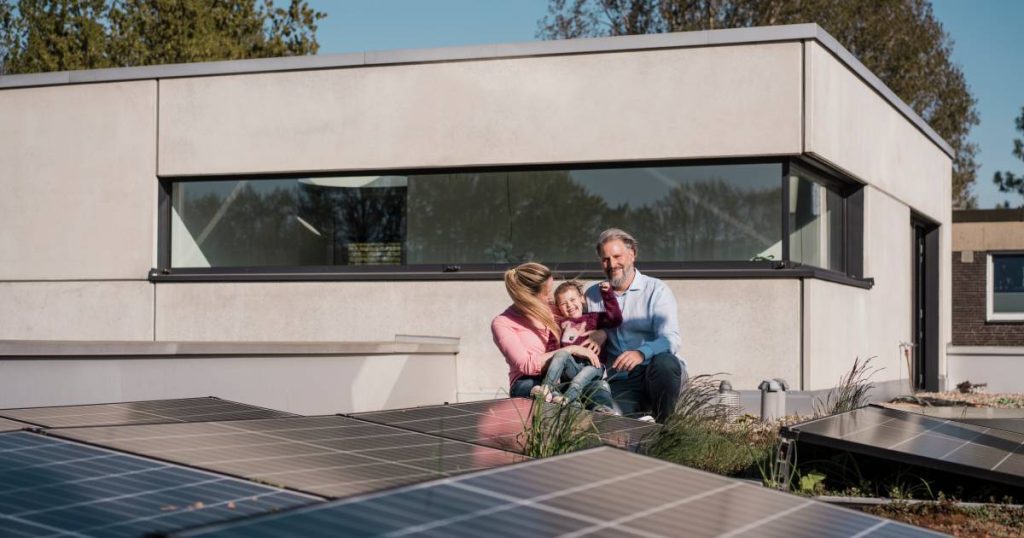liviusPower sharing on the Fluvius network has been possible since 1 July. This means that you can, for example, share the surplus power from solar panels at home with your neighbors, family or friends. Or you can use the extra energy to lower the electricity bill for your second residence. But how do you do that? And what are the benefits? Construction site Livios fluff it out.
With energy sharing, you get an additional option to sell the surplus generated from solar panels. Previously, it was already possible to conclude a feeding contract with a commercial energy supplier. The supplier buys electricity at a certain price. This price is about 19 cents per kilowatt-hour.
Power sharing provides an added advantage. As a participant, you are allowed to agree to a price that is higher than the price paid by your supplier for the injection. The price you pay for the electricity you buy from the grid is about 30 cents per kilowatt-hour (excluding grid rates, taxes and contributions). The people you share with, benefit from it, too. They buy electricity from you at a price somewhat lower than what is common to buy from a commercial supplier. So the price agreed upon between the trader and the receiver lies somewhere between the injection price and the purchase price. In addition, a donation is also an option.
Installing solar panels to lower your energy bill? This is what you need to know about operation and installation.
requirements
“There are really no drawbacks,” says Isabelle van Kotzem, press contact for Fluvius, the operator of the Belgian electricity and natural gas network in all the municipalities of the Flemish region. “There are some conditions. For example, both parties must have a digital meter and they must activate the so-called “Measurement System 3” across their trade supplier.” The way to do this depends on your supplier, but it is usually done over the phone via a service clients. Using the Measurement System 3, the digital meter can read quarter-hour values. To be sure, it’s a good idea to check with the supplier to see if there are additional costs or other terms that apply. Because that can vary for each supplier.
Isabelle van Kotsem explains that “energy sharing is a regional jurisdiction, so each region has established its own legislative framework.” “The ethos of energy sharing is primarily to use energy sustainably and locally. These conditions apply today: sharing must be within the Flemish region and between customers with the same supplier. From 1 January 2023, the second condition will expire and you will also be able to share between customers with different suppliers.
A quarter of an hour is available
It is true that the generated energy that you do not consume yourself, always remains available for fifteen minutes at the address with which you share your energy. “You can use the power in the same fifteen minutes, say from 3 to 3.15 pm. But at 3.01 pm, you can’t use the electricity that was shared at 2.59 pm, another fifteen minutes,” says Gert Phelps, Director Communications at the Flemish Energy and Climate Agency (VEKA).
“We work with a ‘fixed quarter-hour’ and there are four hours in an hour. Not with a ‘moving quarter-hour’ where in the fifth minute of the first quarter you can share that energy up to and include the first five minutes of the next quarter.”
settlement method
“It is billed quarterly because the intent is for people to use it efficiently when energy is available. This policy choice forms the framework of the general agreement within which we operate,” explains Isabelle van Kotsem. “In principle, everything happens automatically between the two energy-sharing parties. If, as a participant, you have an excess of energy after your own self-consumption at a given moment, this energy will be shared with the person with whom you made an appointment and according to their consumption during that 15-minute period If there is still a surplus after that because in the same quarter the ‘recipient’ consumes less than the merchant’s surplus, then the merchant can take a feed-back for this second surplus if he has completed a contract feed. The settlement takes place once a month. As a participant and energy receiver, you can therefore consciously direct toward this together, but this is definitely not necessary. It is actually a kind of overflow system.”
After 1 month of Energy Sharing: 59 Active Energy Communities
On August 1, Fluvius has registered 59 active energy communities since the introduction of energy sharing: two apartments, 26 customers sharing energy person-to-person and 31 connected parties sharing their second address. “In general, we notice that there are quite a few visits to the webpage where you can place the order. So there is curiosity about this new possibility”, says Isabelle van Kotzem. However, this has so far produced only a modest number of energy communities.
Investing in renewable energy? These are the possibilities.
This article was written by our partner Livios.be. Livios.be is an expert website focused on construction and renovation.
Unlimited free access to Showbytes? And that can!
Sign in or create an account and never miss a thing from the stars.

“Total coffee specialist. Hardcore reader. Incurable music scholar. Web guru. Freelance troublemaker. Problem solver. Travel trailblazer.”







More Stories
Bitcoin price rises after new jobs data from US
European stock markets open higher | beursduivel.be
Russia’s oil imports to China decline